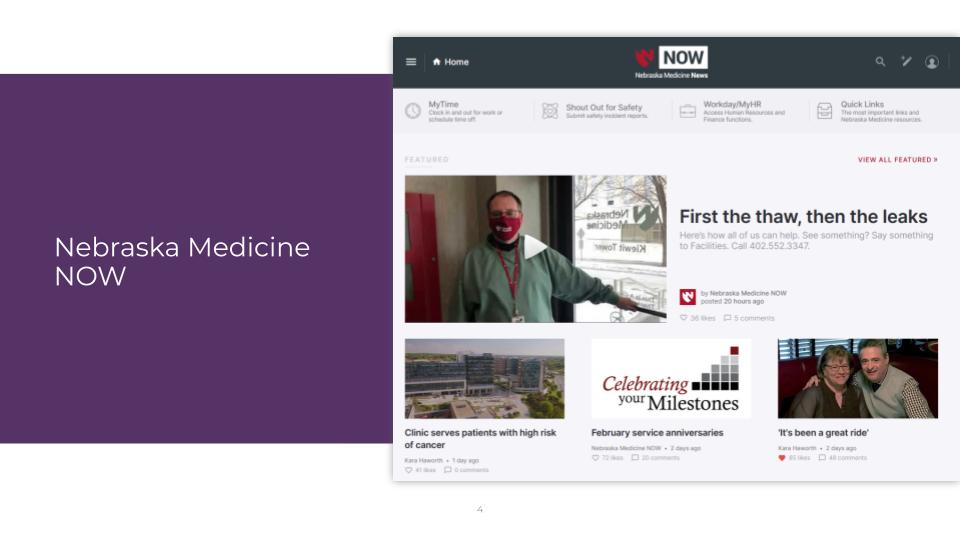Recently, Kyla Turner, Strategic Advisor at Firstup, had the pleasure of speaking with Paul Baltes, Director of Communications at Nebraska Medicine to chat about how one of America’s 100 best hospitals is working to build an omnichannel employee communication platform that can help them address the unique challenges of their dispersed, frontline workforce.
“Healthcare is always complicated, and our system is no exception […] it’s been intense in the last year, but also very critically important. We have felt the impact of the work that we do and have seen it both in the stories we tell internally and externally.”
As one of the largest employers in the state, employing over 11,000 physicians, nurses, industry leaders, and non-clinical staff, close to 60% of their employees are on the frontline, with the added complexity that a majority of their clinical staff maintain dual employment through their research and education partner, the University of Nebraska Medical Center (UNMC).
With a shared campus in midtown Omaha, they see close to a million patients a year with about 40,000 hospital discharges a year. Along with educating thousands of students on campus, UNMC also operates research labs of all sizes, including the largest bio-containment in the country.
Nebraska Medicine was called into action right when COVID-19 first hit, even before the real impacts started showing up nationally. Although none of the team had ever been through a pandemic of this magnitude, the unit had been pressed into action during the 2014 Ebola outbreak in Africa and had a foundation — and an instinct on what to expect. And, as communicators, they knew from 2014 that if COVID did what was being predicted, it would be intense.
Searching for a communications cure
When COVID hit, the communications team of Nebraska Medicine was already on the hunt for a better way to reach employees more effectively. When their current CEO came on board in 2018, people told him, “It’s too hard to get info here. It shouldn’t be this hard.”
After a communications audit provided objective research and interpretation on the type of content being shared and how it was resonating with their employees, they realized their current system was working fine for desk workers, but not for the majority of their workforce who were out providing care to patients, or doing work that supports the care of patients.
“Internal communication is equated with sending an email — and they are not the same thing.”
Luckily, communication was already part of the cultural DNA at Nebraska Medicine, with leaders who had a genuine desire to connect with every worker and get their stories told. Everyone from the CEO to the chief medical officer, chief nursing officer, and IT leadership, through to the clinical chairs and medical leadership wanted to be involved. They understood how valuable good communication can be to a culture, how important culture is to the success of an organization, and the direct connection between communication, culture, and employee retention.
Much like a small newspaper, they had good storytellers. What they lacked was a delivery system. They need more than just an improved communications process — they needed an IT solution as well. If they didn’t have a way to deliver stories and information to the people that are impacted by those stories, then all the great work is lost.
Finding the right fit
Paul explained that Nebraska Medicine ultimately chose the FirstUp platform because of ‘fit’ — synonymous to hiring when a manager is looking for team members that augment each other. By choosing SocialChorus, Nebraska Medicine found a partner that would help build on the strengths that already existed and bring a team approach to their solution — combining communications best practices with the technical expertise needed to build it.
Having access on one call to experts who can talk API configuration then quickly shift to channel building strategies, or give advice on the types of content that are needed for long-term engagement brought a level of collaboration that would have been missed had they chosen a build-it-yourself platform. Knowing they had an experienced group there to help along the way was invaluable.

Adoption success
The branded FirstUp platform, Nebraska Medicine NOW had a tremendous launch and is showing an amazing 90% adoption in just the first few months!
Employees were already familiar with “the NOW” as they call it, giving them a bit of a head start, but Paul attributes this level of success to going “all in”. They made a clear choice to have their FirstUp platform as their intranet, email newsletter delivery system, and mobile app. They knew people would log into the intranet for the “need to have” and if they communicated well and created an engaging space, they’d come back for the “nice to have.”

One of their early communications featured a nurse giving another nurse their first COVID vaccine, which not only got important educational information out to everyone but sparked a conversation between a nurse and an HR team member around CDC guidelines. To Paul, it was a microcosm of everything they were trying to achieve — the creation of a space where everyone can easily ask and answer a question, and it’s answered in a way that others can see and respond to.
“We had elements of this before but not the level of visibility and access that we have with this platform. Before it was just the intranet… now it’s so much more.”
Focusing on employee retention
One of the challenges healthcare organizations are facing today is employee retention. There were several questions from the webinar attendees about how the platform is helping Nebraska Medicine engage with and focus on retention, specifically with the nursing staff who are most at risk in this current climate.
Paul explained how one of the key things Nebraska Medicine focuses on is trust in leadership. There’s a direct connection to the experience an employee has and their desire to stay and grow their career, which is vital in health care now more than ever. Realistically, they don’t expect to hear that someone is going to leave because of an app, but getting good communication “into the oxygen of the workplace” can make it better. If people are better informed and better connected, they’re much more likely to be engaged in the work they do.
“We want to feel that we are doing the most we can to engage the people that work here and that are entrusted with the most important job there is, which is the health and safety of the patients in our clinics and hospitals.”
Tracking and planning for the future
Before launching their FirstUp platform, Paul explained that they had “dumb numbers.” They could see hits on a webpage or clicks in an email but now they can see and track individual results but also see how things are working on a more company-wide level. Sending an email to thousands of people isn’t communicating, but if you can determine when and how people received it, see what they do next, and how it is expanded upon or responded to you, you’ve enabled two-way communication.
“You can’t take action on what you don’t know — and now we know.”
Paul is happy with the early success but was pragmatic when discussing how all communicators need to employ their best change management skills when implementing a new tool. He offered up the ‘wet cement’ analogy, “we want to give people as many tools as we can to build engagement and communication both ways,” so that when the cement dries, the solid foundation is built, and there is a clear pathway for where to go for information.
As a closing note, he provided some advice to anyone looking to improve employee engagement, regardless of where they are in their technology planning:
“Don’t lose sight of the value of communication. It’s not a “nice to have,” it’s a “need to have.” It’s in the bloodstream of every business objective, every element of a mission statement or core value. Be thoughtful and thorough about how you approach it, both editorially and technically and your organization will benefit.”
Download PDF








